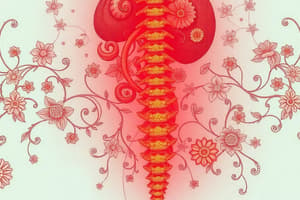Podcast
Questions and Answers
Which of the following is a complication associated with spinal cord injury?
Which of the following is a complication associated with spinal cord injury?
- Muscle spasm
- Autonomic dysreflexia (correct)
- Diminished exercise capacity
- Osteoporosis
What is the main cause of pressure sores in individuals with spinal cord injury?
What is the main cause of pressure sores in individuals with spinal cord injury?
- Exposure to cold
- Impaired sweating response
- Unrelieved pressure (correct)
- Lack of weight bearing
Which level of spinal cord injury usually requires artificial ventilation for breathing?
Which level of spinal cord injury usually requires artificial ventilation for breathing?
- T12
- C7
- T6
- C4 (correct)
Which population group has the highest occurrence of traumatic spinal cord injuries?
Which population group has the highest occurrence of traumatic spinal cord injuries?
Which of the following is a primary feature of spinal cord injury?
Which of the following is a primary feature of spinal cord injury?
What determines the severity of spinal cord injury?
What determines the severity of spinal cord injury?
What is the estimated lifetime cost of spinal cord injury per incidence of paraplegia?
What is the estimated lifetime cost of spinal cord injury per incidence of paraplegia?
What are the consequences of spinal cord injury?
What are the consequences of spinal cord injury?
Which part of the spinal cord is responsible for conducting sensory information from the peripheral nervous system to the brain?
Which part of the spinal cord is responsible for conducting sensory information from the peripheral nervous system to the brain?
What is the function of the dorsal root in the spinal cord?
What is the function of the dorsal root in the spinal cord?
Which level of spinal cord injury allows for normal motor function in head, neck, shoulders, arms, hands, and fingers?
Which level of spinal cord injury allows for normal motor function in head, neck, shoulders, arms, hands, and fingers?
Which syndrome is characterized by complete motor function loss bilaterally, but preserved fine touch and proprioception sense?
Which syndrome is characterized by complete motor function loss bilaterally, but preserved fine touch and proprioception sense?
Which syndrome results from hyperextension and compressive injuries that cause central cord swelling, with impairment of motor function in the upper extremities greater than lower extremities?
Which syndrome results from hyperextension and compressive injuries that cause central cord swelling, with impairment of motor function in the upper extremities greater than lower extremities?
Which syndrome is generally very rare and results from compression by tumor or infarction of the posterior spinal artery, with loss of touch and proprioception below the lesion but preserved motor function and crude touch, pain, and temperature sensation?
Which syndrome is generally very rare and results from compression by tumor or infarction of the posterior spinal artery, with loss of touch and proprioception below the lesion but preserved motor function and crude touch, pain, and temperature sensation?
Which region of the spinal cord has spinal nerves found below the corresponding vertebrae?
Which region of the spinal cord has spinal nerves found below the corresponding vertebrae?
What does the term 'myotome' refer to?
What does the term 'myotome' refer to?
How is the level of the lesion determined in classification of spinal cord injury?
How is the level of the lesion determined in classification of spinal cord injury?
What is the difference between tetraplegia and paraplegia?
What is the difference between tetraplegia and paraplegia?
Flashcards are hidden until you start studying
Study Notes
Complications of Spinal Cord Injury
- Pressure sores are a complication of spinal cord injury, primarily caused by immobility and poor circulation
- Other complications include respiratory issues, cardiovascular problems, and bowel and bladder dysfunction
Epidemiology of Spinal Cord Injury
- The population group with the highest occurrence of traumatic spinal cord injuries is young adult males
Features of Spinal Cord Injury
- A primary feature of spinal cord injury is loss of motor and/or sensory function below the level of injury
- The severity of spinal cord injury is determined by the level and completeness of the injury
- Tetraplegia refers to impairment of all four limbs, while paraplegia refers to impairment of the lower limbs only
Anatomy of the Spinal Cord
- The dorsal horn of the spinal cord is responsible for conducting sensory information from the peripheral nervous system to the brain
- The dorsal root is responsible for transmitting sensory information from the periphery to the spinal cord
- The lunbosacral region of the spinal cord has spinal nerves found below the corresponding vertebrae
Classification of Spinal Cord Injury
- The level of the lesion determines the classification of spinal cord injury
- The level of injury is determined by neurological examination and imaging studies
Medical Terms and Concepts
- Myotome refers to a group of muscles innervated by a single spinal nerve root
- Central cord syndrome results from hyperextension and compressive injuries, causing impairment of motor function in the upper extremities
- Posterior cord syndrome is a rare condition characterized by loss of touch and proprioception below the lesion, with preserved motor function and crude touch, pain, and temperature sensation
- Brown-Sequard syndrome is characterized by complete motor function loss bilaterally, but preserved fine touch and proprioception sense
Economic Burden
- The estimated lifetime cost of spinal cord injury per incidence of paraplegia is significant
Studying That Suits You
Use AI to generate personalized quizzes and flashcards to suit your learning preferences.




